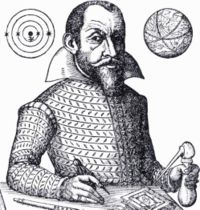- Simon Marius
-
For the 18th-century composer, see Johann Simon Mayr.
Simon Marius 
Simon MariusBorn January 10, 1573
GunzenhausenDied December 26, 1624 (aged 51) Residence Ansbach Nationality German Fields Astronomy Known for Jupiter, Andromeda Galaxy Simon Marius (Latinized from German Simon Mayr) (January 10, 1573 – December 26, 1624) was a German astronomer. He was born in Gunzenhausen, near Nuremberg, but he spent most of his life in the city of Ansbach.
In 1614 Marius published his work Mundus Iovialis describing the planet Jupiter and its moons. Here he claimed to have discovered the planet's four major moons some days before Galileo Galilei. This led to a dispute with Galileo, who showed that Marius provided only one observation as early as Galileo's, and it matched Galileo's diagram for the same date, as published in 1610. It is considered possible that Marius discovered the moons independently, but at least some days later than Galileo.
Regardless of priority, the mythological names by which these satellites are known today (Io, Europa, Ganymede and Callisto) are those given them by Marius:[1]
Simon Marius also observed the Andromeda "nebula", which had also been known to Arab astronomers of the Middle Ages. Discussion of Marius's work is scarce, but what exists tends to note his skill as an observer, including:
- That in 1612 he measured the diameter of the Andromeda nebula and discerned it as having a dull, pale light which increased in brightness toward its center,[2] like "a candle shining through horn".[3]
- That he detected the spurious disks of stars created by his telescope.[4]
- That, from his observations of the Jovian moons he derived better periods of revolution and other orbital elements for them than did Galileo.[5]
- That he observed the location of Tycho Brahe's supernova of 1572 and found a star there which he estimated to be "somewhat dimmer than Jupiter's third moon."[6]
Marius drew conclusions about the structure of the universe from his observations of the Jovian moons and the stellar disks. The stellar disks he observed were spurious (likely the Airy disk caused by diffraction, as stars are too distant for their physical disks to be detected telescopically), but Marius interpreted them to be physical disks, like the planetary disks visible through a telescope. He concluded that since he could see stellar disks, the stars could not be as distant as was required in the Copernican world system, and he said that the appearance of the stars as seen through a telescope actually argued against Copernicus.[7] He also concluded from his observations of the Jovian moons that they must orbit Jupiter while Jupiter orbits the sun.[8] Therefore, Marius concluded that the geocentric Tychonic system, in which the planets circle the sun while the sun circles the Earth, must be the correct world system, or model of the universe.[9]
Work
- Mundus Iovialis anno MDCIX Detectus Ope Perspicilli Belgici (Die Welt des Jupiter, 1609 mit dem flämischen Teleskop entdeckt; Lateinisches Faksimile und deutsche Übersetzung; Hrsg. und bearb. von Joachim Schlör. Naturwiss. begleitet und mit einem Nachw. vers. von Alois Wilder), 1614
- Zinner, E., "Zur Ehrenrettung des Simon Marius", in: Vierteljahresschrift der Astronomischen Gesellschaft, 77. Jahrgang, 1. Heft, Leipzig 1942
- Bosscha, J., "Simon Marius. Réhabilitation d´un astronome calomnié", in: Archives Nederlandaises des Sciences Exactes et Naturelles, Ser. II, T. XII, S. 258 - 307, 490 - 528, La Haye, 1907
References
- ^ Marius/Schlör, Mundus Iovialis, p. 78 f. (with misprint In for Io)
- ^ Bond, George P,"An Account of the Nebula in Andromeda",Memoirs of the American Academy of Arts and Sciences, New Series, volume 3, 1848 pg. 75-76.
- ^ Watson, Fred, Stargazer: The Life and Times of the Telescope, Da Capo Press, 2005, pg. 86.
- ^ Dreyer, JLE,"The Tercentenary of the Telescope",Nature,vol. 82 (December 16, 1909), pg. 190-191
- ^ Pannekoek, Anton, A History of Astronomy, Interscience Publishers, 1989, pg. 231.
- ^ Waldrop, M. Mitchell,"Supernova 1987 A: Facts and Fancies",Science,New Series, Vol. 239, No. 4839 (Jan. 29, 1988), pp. 460-462
- ^ Marius/Schlör, Mundus Iovialis, pg. 46-49.
- ^ Marius, Simon (tr. by A.O. Prickard), "The Mundus Jovialis of Simon Marius", The Observatory (astronomy), vol. 39, 1916, pg. 404, 408, 409
- ^ Marius/Schlör, Mundus Iovialis, pg. 46-49.
External links
- Simon Marius in the German National Library catalogue (German)
- The Galileo Project — biography of Simon Marius.
- Simon-Marius-Gymnasium — Simon-Marius-Gymnasium Gunzenhausen, named after the astronomer.
Categories:- 1573 births
- 1624 deaths
- People from Gunzenhausen
- German astronomers
- People from Ansbach
Wikimedia Foundation. 2010.
